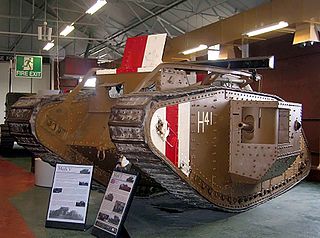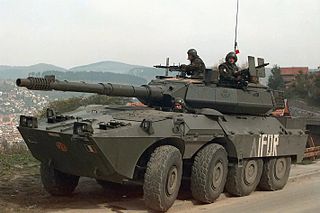Characteristics
The Caproni Vespa was able to accommodate two crew. Its most striking characteristic was the position of the wheels, which were arranged in rhombus or lozenge configuration: one front and one rear wheel (like a motorcycle), and two central wheels, placed on the sides of the hull; basically a 1x2x1 configuration. This gave the vehicle a particularly small turning radius, useful for an armoured car intended primarily for rapid exploration and reconnaissance.
The Caproni Vespa had an 8-cylinder Lancia Astura 82 horsepower engine, which could reach speeds of 86 km/h with operational range of 200 km on road. It was 3.90 meters long, 2 meters wide and 1.85 meters high. The weight was 3.4 tons, with 26 mm frontal armour and 14 mm side armour. Main armament was a 8mm Breda 38 machine gun. [2] [3] [4]

An armoured fighting vehicle or armored fighting vehicle (AFV) is an armed combat vehicle protected by armour, generally combining operational mobility with offensive and defensive capabilities. AFVs can be wheeled or tracked. Examples of AFVs are tanks, armoured cars, assault guns, self-propelled artilleries, infantry fighting vehicles (IFV), and armoured personnel carriers (APC).

The Jagdpanzer 38, originally the Leichter Panzerjäger 38(t), known mostly post-war as Hetzer, was a German light tank destroyer of the Second World War based on a modified Czechoslovakian Panzer 38(t) chassis.

The Leichter Panzerspähwagen was a series of light four-wheel drive armoured cars produced by Nazi Germany from 1935 to 1944.

The Schwerer Panzerspähwagen, is a series of six- and eight-wheeled armoured cars that were used by Germany during the Second World War.

The BRDM-2 is an amphibious armoured scout car designed and developed in the Soviet Union. It was also known under the designations BTR-40PB, BTR-40P-2 and GAZ 41-08. This vehicle, like many other Soviet designs, has been exported extensively and is in use in at least 38 countries. It was intended to replace the older BRDM-1, and has improved amphibious capabilities and better armament compared to its predecessor.

The Sd.Kfz. 250 was a light armoured half-track, very similar in appearance to the larger Hanomag-designed Sd.Kfz. 251, and built by the DEMAG firm, for use by Nazi Germany in World War II. Most variants were open-topped and had a single access door in the rear.

The Humber armoured car was one of the most widely produced British armoured cars of the Second World War. It supplemented the Humber Light Reconnaissance Car and remained in service until the end of the war.

The Ferret armoured car, also commonly called the Ferret scout car, is a British armoured fighting vehicle designed and built for reconnaissance purposes. The Ferret was produced between 1952 and 1971 by the UK company Daimler. It was widely used by regiments in the British Army, as well as the RAF Regiment and Commonwealth countries throughout the period.

The BRDM-1 is a Soviet amphibious armored scout car. It was the first purpose-built Soviet reconnaissance vehicle to enter service since the BA-64 and was built on the chassis and drive train of the BTR-40 armored personnel carrier. It is the world's first mass-produced combat vehicle of its class.

The BTR-40 is a Soviet open-topped, wheeled armoured personnel carrier and reconnaissance vehicle. It is often referred to as the Sorokovka in Soviet service. It was eventually replaced in the APC role by the BTR-152 and in the scout car role by the BRDM-1.

The Marmon–Herrington armoured car was a series of armoured vehicles that were produced in South Africa and adopted by the British Army during World War II. They were also issued to RAF armoured car companies, which seem never to have used them in action, making greater use of Rolls-Royce armoured cars and other types.

BTR-90 (GAZ-5923) is an 8×8 wheeled armored personnel carrier developed in Russia, designed in 1993 and first shown publicly in 1994. It is a larger version of the BTR-80 vehicle, fitted with a BMP-2 turret.

The Centauro is a family of Italian military vehicles originating from a wheeled tank destroyer for light to medium territorial defense and tactical reconnaissance. It was developed by a consortium of manufacturers, the Società Consortile Iveco Fiat - OTO Melara (CIO). Iveco Fiat was tasked with developing the hull and propulsion systems while Oto Melara was responsible for developing the turrets and weapon systems.

The Humber light reconnaissance car, also known as Humberette or Ironside, was a British armoured car produced during the Second World War.

The Panhard 178 or "Pan-Pan" was an advanced French reconnaissance 4x4 armoured car that was designed for the French Army Cavalry units before World War II. It had a crew of four and was equipped with an effective 25 mm main armament and a 7.5 mm coaxial machine gun.

The Autoblindo 40, 41 and 43 were Italian armoured cars produced by Fiat-Ansaldo and which saw service mainly during World War II. Most autoblinde were armed with a 20 mm Breda 35 autocannon and a coaxial 8 mm machine gun in a turret similar to the one fitted to the Fiat L6/40, and another hull mounted rear-facing 8 mm machine gun.

The D-442 FUG and D-944 PSZH are the result of Hungarian domestic development of relatively cheap amphibious armoured scout car and armored personnel carrier series. The FUG and PSZH were exported with limited success, thus it is also known under its Czechoslovak designation OT-65.

The Auto-Saharan Companies were Italian military units specialised in long range patrols of the Sahara Desert. Companies were formed around expert soldiers, riding AB 41 armored cars and FIAT and Lancia light trucks customized to operate in the desert. The units operated from the late 1930s to the Italian surrender in 1943.

The BOV M16 Miloš is a Serbian 4x4 multipurpose armoured vehicle (MPAV) used for military and law enforcement applications. It features a V-hull, integrating floating-floor plates, and blast-mitigation seating to protect occupants against land mines and improvised explosive devices (IEDs). The M16 Miloš was first publicly presented at IDEX 2017 exhibition in Abu Dhabi, UAE.
The Panhard AM 40 P, also known as Model 201, was a prototype French armoured car.



















